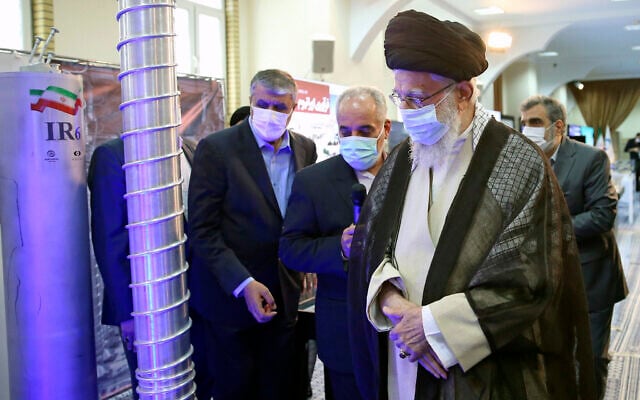UN monitor says reviving Iran deal now irrelevant, since Tehran on cusp of nuke
IAEA’s Grossi cautions negotiators hoping for another pact will need to formulate fresh technical guidelines conforming to ‘new reality’ of Iran becoming a nuclear threshold state
The Times of Israel
Dec 17, 2024
The UN’s top atomic regulator said this week that there was little point in trying to revive the 2015 nuclear deal between Tehran and world powers, with Iran already practically a nuclear threshold state.
The comments by International Atomic Energy Agency head Rafael Grossi in Italy on Monday underlined growing frustration by the UN monitor toward Iran, which has blown past stockpile limits set by the landmark pact and spurned inspections since Washington abandoned the deal in 2018.
Under the 2015 Joint Comprehensive Plan of Action, Iran was only permitted to enrich uranium to 3.68 percent purity, a level consistent with civilian uses of nuclear technology that Iran claims are its only pursuit, capping its stockpile at 300 kilograms.
But according to an IAEA report handed to member states and leaked to the press earlier this month, Iran has begun dramatically expanding its production of uranium enriched to near-weapons grade levels, collecting enough material for several bombs already.
“The philosophy of the original accord with Iran can be used, but that agreement is no longer useful,” Grossi told Italian news agency ANSA on the sidelines of a meeting at the foreign ministry in Rome.
He added that Iran had “developed much stronger capabilities” regarding various aspects of its nuclear program.

“It has uranium at 60% — 90% is military grade — and is thus practically at the same level as nuclear-armed states,” Grossi said.
Sealed in 2015 following years of tightrope negotiations between Iran and the US, UK, Germany, France, China and Russia, the JCPOA was hailed by its boosters as a watershed opportunity to curb Iran’s rogue nuclear activities, with world powers agreeing to lift sanctions that had crippled the Islamic Republic’s economy.
According to the IAEA at the time, before the accord, Iran had amassed just over 200 kilograms of uranium enriched to 20% purity, and around 10,000 kilograms of low-enriched uranium at levels of 5% purity or lower.
Under the deal, Iran was forced to reduce its stockpile by some 98%, and shut down over half of its centrifuges, according to officials.
But the accord was pilloried by Prime Minister Benjamin Netanyahu, who alleged that Tehran had hoodwinked the world and was continuing to covertly pursue a nuclear weapon to be used against Israel.
With other US allies in the Gulf also suspicious of dealing with Iran, then-president Donald Trump pulled Washington out of the accord in 2018, and failed to deliver on a promise to renegotiate a better deal. Attempts by US President Joe Biden’s administration to negotiate an American return to the pact fell apart in mid-2023, and Trump’s impending return to the White House has punctured hopes for reviving the deal.
Iran has steadily ramped up enrichment activity since the US left the deal and reimposed sanctions, rolling out advanced new centrifuges and issuing warnings that it could speed up the process even further.

In a report in early December, the Office of the United States Director of National Intelligence warned that “Iran now has enough fissile material to make more than a dozen nuclear weapons,” but said it had not yet decided to break out to a bomb.
Iran is not thought to have begun work needed to build and deploy a nuclear weapon, a move which, if detected, would likely invite a harsh Western response. But the sheer size of its stockpile and the fact that 60% purity is just a short technical step away from the 90% needed for a bomb, have served to heighten tensions, with Israel rumored to be mulling military action aimed at destroying key nuclear sites.
In its report earlier this month, the IAEA warned that Tehran likely had enough material to build four bombs. Grossi said at the time that Iran was set to begin producing 60%-enriched uranium at eight or more times the current rate.
He told ANSA Monday that given Iran’s “new reality,” the international community would need to rethink the technical steps of a denuclearization agreement with Tehran.

“We must reformulate the agreement,” Grossi said. “This is a complex process whereby the European countries and the US, Russia, and China will have to sit at the table with [the IAEA] to define a system that serves the new Iranian reality.”
The UK, France, and Germany have already expressed hopes of convening talks with Iran before October 2025, when some parts of the deal are set to expire, including its endorsement from the UN Security Council.
Iran has always denied seeking nuclear weapons and says both its space program and nuclear activities are for purely civilian purposes. However, US intelligence agencies and the IAEA say Iran had an organized military nuclear program up until 2003, and continued to develop its nuclear program beyond civilian necessity. Israel contends that the Islamic Republic never truly abandoned its nuclear weapons program.

Iran is committed to Israel’s destruction. Over the past year, it has twice fired massive barrages of missiles at Israel, which has vowed to prevent Tehran from obtaining nuclear weapons. Israel has struck key Iranian military facilities in retaliation for both attacks, which came in the context of a multifront war opened by Iranian terror proxies on the Jewish state.
On Saturday, the Washington Post reported that Israeli strikes in October had severely curtailed Iran’s ability to produce ballistic missiles, which Israel fears could be used to carry a nuclear warhead.
No comments:
Post a Comment